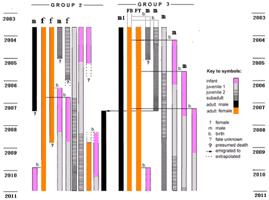Dr. Xue-Long Jiang, Professor. His laboratory is mainly interested in specimen-based investigations of the biodiversity inventory, taxonomy and systematics, phylogenetics and phylogeography of small mammals, especially in those of the Henduanshan region. His lab also focuses on the ecology, behavior and conservation of endangered species, such as the black crested gibbon, musk deer and other large mammals.
Email:jiangxl@mail.kiz.ac.cn
1. Multilocus phylogeny reveals cryptic diversity in shrew like moles (Uropsilus, Talpidae, Mammalia)
The genus Uropsilus comprises the most primitive living talpids (Talpidae, Mammalia), however, the taxonomy, phylogeny and evolutionary histories of these animals were poorly understood. To provide insight into the systematics of this group, we estimated a multi-locus phylogeny, including fine taxon sampling throughout their distribution ranges. We sequenced ~ 6 kb sequences of 10 genes, recovered 10 distinct lineages and 8 putative species within the 3 recognized species. Our results highlight the existence of cryptic and hence potentially new species. Taxonomic revision based on comprehensive morphological and morphometric approaches is warranted. The conservation status of Uropsilus spp. should also be re-evaluated as most of the species/potential species have very limited distribution.

Fig. 1 Nuclear gene network trees and distribution of each putative species.
2. Copulation and reproductive characters in free ranging groups of western black crested gibbon (Nomascus concolor jingdongensis)
Based on population monitoring over 7 years and direct observation for 26 months of the study groups in Wuliang Mountain, central Yunnan, we described for the first time the copulation behavior and breeding pattern of free-ranging western black crested gibbons. We observed 2 intra-group copulations and 5 extra-group copulations. Copulations were initiated when a female gave a ‘solicitation’ gesture. When a male made any mating attempt, the female might refuse it. These results demonstrate direct female mate choice.
The average breeding interval is 3.5 years, and infant independents at approximately 2.5 years. Both male and female gibbons dispersed from their natal groups and sometimes replaced paired adults in other groups. Our results indicate a flexible social organization and complex mating system in this species.


Lab Staff:
Staff:
Ding-Qi Rao, Associate Professor
Bei Huang, Assistant Professor
Kai He, Assistant Professor
Xue-You Li, Assistant Professor
Dong-Ru Zhang, Assistant Professor
Su Lin, Assistant Engineer
Wen-He Ning, Research Assistant
Graduate Students:
Nai-Qing Hu, 2009;Tao Wan, 2010;Xi Liu, 2011;Bin Zhang, 2012;Zhong-Zheng Chen, 2012;
Ran Dai, 2012;Quan Li, 2012;Qi-Long Zhao, 2012;Cheng Huang, 2013;Narayan Kaju
